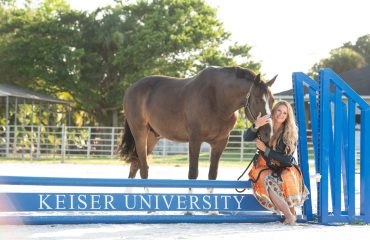
Photo by Lahorstman Photography
Shannon Peters is a U.S. Dressage Federation bronze, silver and gold medalist, and three-time National Championship competitor. She loves bringing young horses up through the levels, and competes regularly both in Southern California CDIs and other top shows. Shannon is married to Olympic dressage rider Steffen Peters, and together they operate Arroyo Del Mar in San Diego, California. Do you have a question you want Shannon to answer? Send questions to editor@sidelinesnews.com.
How do you help your students set goals? Do you use shows as goals, or wait until all the skills have already been developed before deciding to enter a particular show?
Oftentimes, having a date set to go to a competition helps to align the goals in students’ riding to what level they’d like to be competing at, and what training for both horse and rider is required to be successful. It also helps to keep the training realistic, and goals are based on attaining a certain level of competence and confidence at the level both at home and competition. I mostly want my students to feel extremely confident in their skills to ride a very good test, and for that to happen, all of the exercises of the test need to be quite easy to ride at home. From that point, each time a student competes, we reassess the goals accordingly, so both horse and rider continue to feel like they’re making progress and becoming more proficient riding at each level.
What advice would you give someone whose confidence has been shaken after a mishap?
We all have lost our confidence, certainly more than once! Self-doubt is one of our biggest hurdles to overcome when a rider has been injured or frightened on a horse. Sometimes it takes getting right back on; sometimes it takes a detailed thought process and plan to put a rider’s mind at ease. Figuring out your fear trigger as a rider, and figuring out what may trigger the behavior in your horse that may reinvent the problem for both, is ultimately important.
What do you think of horses that “foam” at the mouth when working?
Foam is a good thing! It usually signifies a relaxation of the poll and jaw muscles, and proper acceptance of the bit. It also will usually (but not always) signify a noseband that’s not adjusted overly tight. Sometimes foam can be induced with GumBits or sugar, too, which some horses enjoy and can help them to relax and chew.
How do you deal with a horse that tends to come above the bit?
There are many reasons why a horse may come above the bit. In a lesson situation, I have to quickly analyze how and why it’s happening. Is it a lack of understanding on the horse’s part on what the aids mean? Or lack of understanding on the rider’s part? Or a combination? The immediate reaction from a rider when a horse goes above the bit is to pull, and this just encourages the behavior from the horse even more. So I’ll try to break it down into simple requests from both horse and rider to help them gain an understanding of the most basic aids of how a horse learns to “go on the bit,” and work forward from there — such as, in the halt: “Does your horse soften when you apply gentle pressure to the rein?” If this works, I ask the rider to gently close the calf and ask the horse to walk forward. What was the response? Delayed? Dull? Or easily forward? If the horse was above the bit, I’d assume usually that the horse is equally behind the leg. Next, if the rider asks the horse to make a simple turn, do they follow the rein, or do they keep going straight or become crooked? These are some of the simple things to think about that help to establish the basic understanding between horse and rider of what it means to be “on the bit.”













